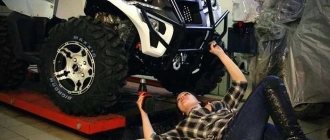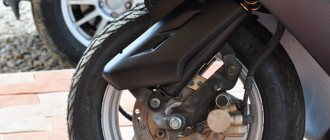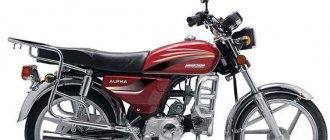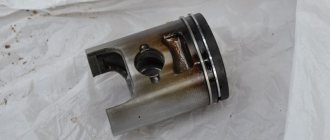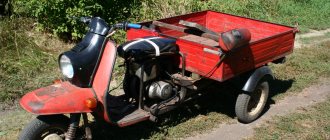Piston group
If the compression in the cylinder is insufficient, the dynamic performance of the scooter will also decrease.
The cause of such a malfunction may be worn out rings or the use of low-quality spare parts. Compression may decrease due to incorrectly performed boring, long-term operation of the scooter at the limit of its capabilities. To identify the malfunction, you need to turn the kick starter. If no resistance is felt, then the pressure is insufficient. The exact value can be determined using a compression meter. It is optimal if the indicator is at 10 bar. If the pressure is low, the piston group must be replaced.
Solutions
What to do if the starter turns but the engine does not catch and the car does not start?
This problem can be resolved in two ways. For example, use the kick starter located on the left side near the engine. Pressing it will activate the remaining energy in the generator, and this small dose of energy will start the battery. This charge will not last long, but will allow you to get to the nearest place to charge. The generator's armature and brushes store enough energy to revive the battery. But this is not the only way to “save” the battery:
- if the scooter does not start (there is a spark, there is gasoline), just charge the battery for several hours. The current level should be similar to that in the battery. Otherwise there is a risk of the battery burning out.
Piston problem
What to do if the VAZ-2107 does not start
The scooter does not start for this reason. Very often, problems can occur based on wear of the piston complex. An internal combustion engine (two-stroke or four-stroke - it doesn’t matter) consists of several parts: a cylinder, a piston and its pin, as well as piston rings. Worn and worn parts cause the engine to lose power and then break down completely. It is not necessary to buy a new cylinder, since the old version can be restored or bored. It can be made higher than zero. This saves a lot of money. When replacing it, it is advisable to purchase all components of a new piston in one set. This is necessary so that wear and tear occurs evenly in the future, and not in parts. The piston, like the rings and the pin, must work synchronously. Then the likelihood of your vehicle breaking down will be significantly reduced. Any breakdown in the case of an inexperienced driver can seem catastrophic, especially if we do not see any explainable reasons for what is happening. However, a minimum of knowledge and skills will help to identify the reason that prevents you from starting a scooter and leading a full motorcycle life. Contact a specialist at a car repair shop or try using the above recommendations - any problem can be solved. Now you can stock up on the information received and in time figure out the reasons why the scooter does not start, and take the necessary measures to resuscitate it on your own in your personal garage or under the supervision of an experienced friend .
So, we have found out the main causes of moped breakdowns and how to fix them yourself. At this point, the main question of the article “why the scooter does not start with the starter” can be considered closed.
Reasons why the car doesn't start well when cold
What to do if the starter does not turn, the relay does not click and the car does not start
On automobile forums you can often come across the question: why does the engine start poorly when cold? It happens that a person has driven a car for some time, parked it, the engine has cooled down, and when he needs to drive again, it either does not start at all or starts, but with great difficulty. Moreover, if the engine has not yet completely cooled down, then it starts up calmly. Why is this happening?
There are two basic reasons - either it is 1) a problem in the fuel supply, or 2) a problem in the ignition system.
The following malfunctions lead to incorrect fuel supply:
1. Poor quality fuel. 2. The injectors are clogged. 3. The coarse filter is clogged. 4. The fine fuel filter is clogged. 5. The throttle valve is clogged (cleaning the throttle valve). 6. The idle jet is clogged. 7. Insufficient pressure in the fuel pump. 8. Fuel pressure is not adjusted correctly. 9. The air filter is clogged. 10. The outside temperature is too low to start the engine.
Now you need to determine whether, in your case, there is a problem with the fuel supply - the spark plug will tell you about this. You need to turn the starter, unscrew the spark plug and inspect it: if it is filled with gasoline, it means that too much fuel is entering the combustion chamber; if it is completely dry, it means that not enough fuel is entering.
Next, refer to the list of faults for fuel supply problems listed above and identify this fault.
If the engine doesn’t start well when cold, but you still haven’t found any problems with the fuel supply, then the whole point is in the second reason: there is a problem in the ignition system.
The following reasons lead to malfunctions in the ignition system:
1. The spark plugs are worn out (how to check the spark plugs). 2. The battery is discharged, and the starter turns very weakly, at an uneven speed. 3. The ignition distributor is faulty. 4. The high-voltage wire is broken or punctured (in a dark place, when starting the engine, a glow will be noticeable on this wire). 5. The ignition coil is faulty (if there is only one, you can check it with a multimeter).
If the compression pressure in the combustion chamber has sharply decreased, this will inevitably lead to problems with fuel ignition.
Reasons for decreased compression pressure: 1) engine wear; 2) incorrectly set valve clearances (VAZ valve adjustment); 3) the timing belt is installed incorrectly.
Of course, if the car engine does not start well when cold, you should not immediately rush to disassemble the injector, reinstall the timing belt or repair the fuel pump. Still, such reasons happen quite rarely. You need to start by identifying simple causes and, as they are eliminated, approach more complex ones.
Pay attention to the candles
If you bought a used scooter or haven't had it serviced for a long time, you need to start by inspecting the spark plugs. This procedure is carried out to assess the condition of the parts. If a melted electrode is detected, the spark plugs are changed. Here are a few steps you need to take to restore the ignition system:
- Clean the spark plugs from dirt and carbon deposits with a wire brush.
- The part is washed and dried over a gas stove or near a heating device.
- Check the operation of the spark plugs.
It is easy to check the functionality of the part. You need to take it out, touch the spark plug to the engine (in a place where there is no paint). Now turn on the ignition and turn the crankshaft. The working candle will create a blue spark. If the spark is yellow or does not appear at all, the ignition system element needs to be replaced.
Cleaning the spark plug
The scooter also has trouble starting if soot settles on the spark plug. This is a combustion product that gradually forms on the part due to constant combustion processes in the engine. This situation occurs if the balance in the ratio of oil and gasoline used is disturbed. This is most common in scooters with two-stroke engines. When the engine is four-stroke, the source of the problem is most likely only in gasoline. It is necessary to use fuel with a higher octane number - from 80 and above. You can clean a candle by burning it. This element is unscrewed from the cylinder and its base is burned in a flame of fire. At the end, this part is wiped with very light sandpaper with fine grit and screwed into place. After all these activities, the moped should begin normal operation.
How to start a scooter in cold weather?
If you have a scooter with a two-stroke engine, then there should be no problems with starting.
It will start easily in at least -20°C. However, there are some important points to keep in mind. Firstly, the scooter must be filled with fresh gasoline, and not stale gasoline from the summer.
Secondly, it is better to use synthetic oil - it does not thicken as much as mineral oil. In any case, if you already have oil in your oil tank, check to see if it has turned into jelly. To do this, unscrew the oil tank cap, tilt the scooter and look through the hole to see what happens to the oil.
Thirdly, at low temperatures it is more difficult for the engine to work due to thickened oil, stiffened belts, and gasoline evaporates worse. Therefore, it is better to start it not with an electric starter, but with a kick starter.
There are no tricks in the procedure for starting the engine in winter: you need to pull the kick starter leg in the same way as at any other time of the year. If the scooter does not grip very well when cold, then start it with the throttle slightly turned off so that the fuel mixture is richer.
Of course, the main condition for successful starting in cold weather is the cleanliness of the carburetor and its correct settings. Remember to clean your carburetor at least once a year.
After the engine starts, you should not ride the scooter immediately. You need to wait a few minutes (5-7) for the engine to warm up well at idle. Otherwise, it is possible to get the so-called thermal seizure, which threatens scoring on the cylinder walls.
Please note: This article and the images in it are subject to copyright. Partial or complete reproduction on other resources without permission is prohibited.
Source
The motor belt is damaged
The scooter does not start - there is a spark, there is gas, but there is no reaction. Another source of the problem may lie in a deformed belt in the motor design. This technical element makes a huge number of revolutions during the day. It is located on the same side as the kick starter, under the motor cover. The belt itself is a consumable, replaceable element of scooters, so sooner or later it will need to be replaced. It cannot be restored, all that remains is to buy a new one in a store that sells components for motorcycles.
When purchasing this spare part, it is recommended to pay attention to the overall diameter of the belt and the thickness of the rubber layer - they must correspond to the model of the scooter and its configuration. Otherwise it will not work on your moped
Preparing your scooter for winter
Even in a heated garage there is moisture, be it melt water or condensation. It especially harms frames that are not very well painted, screws and nuts. If you have the opportunity to purchase oil in a can, then good; if not, then use regular oil and a cloth. Lubricate the metal parts of the frame, engine, front fork with a thin layer. OIL SHOULD NOT GET ON THE BRAKE DISC, drop a couple of drops into the ignition switch and luggage compartment.
The brake lever and rear brake adjustment mechanism must be cleaned. The nut on the rear brake drive rod should turn easily, the thread should be clean. If you ride in winter, lubricate the moving parts and components of your scooter. This prevents the penetration of water and salt. The throttle and brake cables should also be lubricated. To do this, tighten the cable tensioning mechanisms on the gas handle (brake lever) until you have access to the cable; drop a little oil on the cable and move it back and forth, repeat this several times. After lubrication is complete, adjust the tension of the cables and remove excess oil. Pay attention to whether the brake cable running under the engine is securely fastened.
If you are not going to drive in winter, then fill up a full tank of gasoline. This will prevent rust from appearing on its inner surface. It also wouldn’t hurt to add 50 ml of oil for two-stroke engines to the gasoline. The oil forms a thin film on the inner surface of the cylinder and piston in the carburetor, which will prevent rusting. This oil will not harm the engine. After this, start the engine and let it run for 10 minutes.
Standard tires are not designed for winter driving. Already on a wet road, the scooter slips; at low temperatures, the rubber hardens, so for winter trips, use winter or all-season tires. It is also recommended to lower the tire pressure by about 0.2 - 0.3 and place the scooter only on the middle stand, this relieves the load on the wheels. It is recommended to place a couple of planks under it, it will be even better for the wheels.
The battery requires special attention. Add distilled water to it (if necessary). NEVER ADD ACID!, lubricate the contacts with Vaseline. For the winter, remove the battery and bring it home. Charge the scooter battery using chargers designed for this purpose. The charging current is usually from 4 to 6 A. Try not to exceed these values. Before charging, open the battery cap (if equipped). Charging must be done at a temperature not lower than 10 degrees. The battery should be recharged once every two months.
Please note that motorcycle plastics become brittle at low temperatures. Even minor shocks and vibrations from the motor can damage the plastic lining.
Rubber is sensitive to frost. During wintering, wheel tires may crack (even if the wheels are not loaded) and, very importantly, the variator belt. Therefore, it is necessary to wash the wheels and treat them with a special compound that protects the rubber. It is advisable to reduce the tire pressure by half in order to reduce internal stress in the tires; this measure will extend the life of the rubber. The same applies to the variator belt.
In winter, the front shock absorber feathers often suffer from moisture and condensation. And as a result - hopelessly damaged shock absorbers after 100 km of run in the next season, since rust on the feathers eats up the shock absorber bushings or oil seals (if the shock absorber is hydraulic). To prevent this, it is necessary to clean the shock absorber feathers from dirt, and then treat the surface of the feather with a thin layer of grease.
When driving in winter, salt corrodes aluminum wheel rims. Therefore, after each trip it is necessary to wash them, wipe them dry and treat them with a special compound.
As an alternative to adding oil to gasoline, it is recommended to unscrew the spark plug and drop a couple of drops of oil into the cylinder, then use the kick starter leg to crank the engine several times.
Very often, when the scooter is parked in winter, the surface of the driven pulley cheeks becomes covered with rust. If you do not take measures to prevent corrosion of the working surface of the driven pulley, then after putting it into operation next season, the belt will wear out very quickly or completely fail. To protect the working surface of the driven pulley, you can use the same grease applied in a thin layer (only then it will be necessary to remove it so that the belt does not slip).
It would be a good idea to service all the cables in winter, and especially the speedometer cable. It is he who primarily suffers from condensation. It is not difficult to serve. You just need to remove it, remove the cable from the sheath, lubricate it with oil and reassemble everything in the reverse order. With the brake and gas cables, things are somewhat more complicated, since they are non-separable, so you will have to be smart to spill lubricant between the cable itself and its sheath, but I advise you to do this procedure, since the service life of the cable in this case will be significantly extended.
If the room in which the scooter is stored is very humid, then there is a possibility that the crankshaft journals in the places where it mates with the oil seals may also rust. This is fraught with damage to the working edges of the oil seal due to corrosion products of the crankshaft journal and failure of the oil seal. Therefore, the crankshaft journals in the area of their interface with the oil seal should be treated with an aerosol penetrating lubricant. If the scooter owner does not have sufficient skills to dismantle the variator clutch and generator rotor (to provide access to the crankshaft seals), then it is better for him to contact a specialist.
Fuel system
If there are problems with starting in cold and warm weather, you need to check the enrichment tank, gas tank, filter, tap. Perhaps the reason lies in the malfunction of the carburetor or pump.
To check the valve, the hose is disconnected from the carburetor and the crankshaft is turned. If there are no problems with this element of the system, fuel will begin to drain from the tube. If this does not happen even when the engine is running, you need to replace the valve.
It is worth assessing the condition of the fuel filter. If the cleaner is clogged, you need to change it. Even if the filter seems clean, if it cannot be blown out, there is a blockage in it.
Contamination in the carburetor can also cause the scooter to not start. Cleaning is carried out according to the following scheme:
- The carburetor is dismantled and disassembled.
- All holes are blown out with compressed air.
- Inspection of the float chamber.
- Cleaning the fuel nozzle from contamination.
If the gasoline has not been changed for a long time, it is drained after idle time. After filling the tank with fresh fuel, try starting the engine again.
The listed actions almost always solve the problem of poor starting of the scooter.
Views 1,302
Principle of operation
Why won't my scooter start? There can be many reasons for this - from a small malfunction of the engine to a serious breakdown. A moped differs from other types of vehicles in that it is an economical mode of transport. A typical average scooter has a 50cc engine, which is unable to burn too much fuel while driving. This explains the fact why it cannot reach very high speeds. The maximum he can do is move at a speed of no more than 60 kilometers per hour. At the same time, the safety of the moped driver is at risk, since no side safety bars are provided here, as on full-fledged motorcycles. But the reliability and simplicity of the design of this relatively cheap transport are so convenient for everyday use that the scooter has always been, is and will be popular among the people. But even the most unpretentious equipment sooner or later begins to act up and let its owners down. And then one fine day you are faced with the fact that the scooter will not start. This may be due to careless handling, lack of timely technical inspection, as well as objective extraneous causes, consequences of an accident, and the like.
Rules for riding a scooter in winter
Clothing is the first thing to think about if you want to ride a scooter in winter. You need to dress not just warmly, but also resistant to the wind (insulated gloves, overalls, windproof jacket).
Minor accidents (such as hitting a curb while parking) may not cause any harm during the warmer months. In winter, the plastic becomes brittle and can crack or break off even from slight vibration of the scooter engine.
In the summer, many scooter drivers neglect safety and ride a moped without a helmet, but driving in winter requires greater attention to safety, since the snow makes the scooter more likely to skid. A helmet (best of all - a closed one) will protect your head not only from injury, but also from frost and cold wind.
Braking a scooter on a winter road follows completely different rules than in summer. When approaching an obstacle or stopping place, should you gradually slow down? Moreover, you need to brake using the engine, not the front brake disc. If you apply the front brake, the wheel will jam, the tires will begin to slide, and the scooter will stop much further than the intended place.
When starting to ride a scooter, you should be careful, do not squeeze the throttle fully, but turn it no more than a third, otherwise the wheel will begin to slip, the back of the scooter will be thrown to the side, and the driver will fly off his “iron horse”. The maximum speed that can be reached in winter? 30 kilometers per hour
If the speed is exceeded, the moped may become uncontrollable and simply fly off the road.
The maximum speed that can be reached in winter? 30 kilometers per hour. If you exceed the speed, the moped may become uncontrollable and simply fly off the road.
The hardest part about winter driving is the turns, which should be started early. Slow down in advance, and when turning, tilt the scooter slightly to the side, but make sure that the tires do not slip.
For example, when turning left, the speed is reduced to 10-15 km/h (the more snow - the lower the speed), and then the scooter tilts slightly to the left.
be careful
Do not forget that riding a scooter in winter is a very dangerous activity. The driver risks not only his own health, but also the health of others. Those who decide to drive in winter must be extremely careful, constantly monitor the situation and not allow themselves to be distracted. It is also worth remembering that even winter tires designed for driving in aggressive conditions will become hard, slippery and difficult to control.
Still, the best option is to store the scooter in the garage until spring.
A cold scooter (moped) engine does not start - looking for the reason
You can often encounter a situation where a warm scooter engine works fine, but when it’s cold, problems arise and starting it becomes extremely difficult, and in some cases, impossible. In this case, you will not be able to start the scooter using either an electric starter or a kickstarter. In this case, the problem usually lies in the ignition system or in the power system. Both breakdowns require serious attention and adherence to clear instructions, which I will describe below. Since most often the problem lies in the ignition system, let’s consider this point in more detail. After that, let's move on to the power system.
The scooter does not start due to problems in the ignition system. To begin with, we unscrew the spark plug and examine the electrodes; if they are melted or have any defects, we replace the spark plug with a new one. If the spark plug is wet, be sure to remove it from the cap and dry it, for example, I do this on a gas stove. Now we insert it back into the cap and check for the presence of a spark. How to check for a spark on a scooter, the scooter will not start due to problems with the spark plugs. To do this, you need to attach the spark plug to an unpainted part of the engine, usually to the cylinder, and crank the crankshaft using an electric starter or kick. Before doing this, do not forget to turn on the ignition of the scooter. You should not check the spark with your bare hands; you should definitely protect yourself with special thick rubber gloves or a piece of rubber. Another point to consider is that the spark plug must be kept away from the spark plug hole in the cylinder head, since gasoline can splash out from there and ignite. In my practice, this has not happened, but the recommendations should not be neglected. When the crankshaft is turned sharply, a blue spark should run through the spark plug, quite powerful and constant. If there is no spark, or it is yellow and appears occasionally, first of all, we take it as faulty and check the spark in the same way on a new spark plug. As a rule, in more than half of the cases, at this stage the problem is solved and the scooter works properly
That is why it is so important to always have a working spare spark plug with you, which will always save you on the road in such a situation. If, after you have installed a new spark plug, the problem remains, we look further for a known faulty place: The scooter does not start due to a faulty spark plug cap or connection with it
It also happens that the cap may not be in sufficiently tight contact with the high-voltage wire. To exclude this from the possible causes of the malfunction, we must check it. Unscrew the cap from the wire and bring the wire 2-3 mm to the metal part of the engine
Please note that if, in the case of a spark plug, we pressed it against the engine, then in this case the specified distance must be maintained. Rotate the crankshaft and pay attention to the end of the wire, a spark should jump between it and the engine (do not forget that we are doing all this with the ignition on). If the spark appears, you can breathe a sigh of relief
We examine the spark plug cap, if it is wet (and often because of this the normal spark disappears), then we dry it with a hairdryer, replace the spark plug and check the spark. No changes? Then we replace the cap with a new one and go. Now consider the option in which there is no spark even on the wire. This phenomenon can happen with the so-called current leakage. The essence of this phenomenon is that any exposed section of the high-voltage wire touches the metal part of the scooter. This may not happen directly, and the role of a conductor can be played by water, which accumulates in the area of the bare area when driving through puddles. Look carefully at the wire running from the spark plug to the ignition coil; if you do not find any places of disconnection or damage, then you can assume more serious breakdowns in the ignition system, namely: the ignition coil has failed; the ignition sensor (hall sensor) has failed; the switch is faulty; Any of these elements, if faulty, can cause a lack of spark or unstable operation of the scooter engine
You shouldn’t buy them right away; it’s important to determine which electrical appliance is faulty. To do this, for example, you can borrow exactly the same one from a friend to check
The scooter does not start due to problems in the power system.
Typical reasons
Starting a scooter in cold weather may not always be possible due to various factors. First of all, you shouldn’t torture the equipment if it doesn’t start right away. Check the following:
- Battery condition. If its charge is less than 12 A, the starter will not work. The normal voltage should be 14.5, this can be checked using a voltmeter. Try kickstarting the scooter.
- No spark. If the scooter was working fine, but then stopped starting, you should check to see if there is a spark. To do this, you need to pull out the spark plug and check its condition. The problem could also be with the coil or switch.
- The equipment may not be satisfied with the quality of gasoline.
- The malfunction may be hidden in the power system. If the scooter has trouble starting when cold, try adjusting the carburetor.
Malfunctions in the power system
The power system may be to blame; If the piston group of the engine is working properly, then you should check whether gasoline enters the combustion chamber or not. This is easy to check: unscrew the spark plug and inspect it; if it is wet, it means gasoline is flowing. If it’s dry, we start checking with the gas tank: first, you need to find out if there is gasoline in there. If there is, check whether the tap is open. If everything is open, you need to remove the vacuum hose and clean it with air.
If everything is in order, move on to the carburetor float chamber. The bottom of the device is removed; it is usually held on by bolts. It contains a float. If the chamber is full, but gasoline does not flow to the cylinder, the nozzle is most likely clogged. You will need to pull out the needle, remove debris, dust, and all foreign particles. You can also check the scooter's petal valve: it is located below the carburetor. The petals may be damaged, causing the scooter to not start even if it is new. If the petals are not closed tightly enough, the valve must be replaced. In some cases, you can bend the petals with your fingers, but this measure will only help for a short time - only to start the scooter several times and ride it for parts.
In case of serious damage, you should check the piston, whether it gives the required compression ratio, the seals of the piston system, the CPG and the ignition system. But these reasons are more likely characteristic of old equipment that was not properly cared for.
No spark in spark plug
First of all, you should check the spark plugs if the moped does not want to start.
- The spark plug needs to be unscrewed. You can check it using a special device that is sold in car dealerships; it's inexpensive. You can inspect the candle visually. It should not be black or damaged.
- If the candle is wet, it needs to be dried. This should not be done with open fire.
- The candle may be stained with oil and carbon deposits may be visible on it. All this is cleaned with metal brushes, similar to toothbrushes.
- An easy way to check if there is a spark is by unscrewing the spark plug, putting the wire on it leading to the ignition coil and placing it on the cylinder. If you turn the starter, you will see a spark. If the spark plug is working but there is no spark, the problem is in the ignition coil.
Attention! The procedure must be carried out carefully, without touching the scooter frame or other metal objects with your bare hands, otherwise you will get an electric shock.
If there is a spark and its color is yellow, then you need to install a new spark plug; yours is no longer suitable for use. A normal spark is blue and flows continuously.
If the coil is new, as are the spark plugs, but there is no spark, it is still worth checking the following:
- Oxidation of electrical wire contacts. They will need to be cleaned; for example, the wires going to the battery often become oxidized.
- No spark on the wire. This means that somewhere there is a bare wire that touches an ungrounded metal part, because of this the spark does not appear, since the current does not reach the coil. Check the wiring.
- The switch may also fail. This is an inexpensive item that it doesn’t hurt to always have in reserve.
Probable causes of breakdowns
Why won't my scooter start? There may be a variety of reasons for this. You take it to the track to start and go to work or for a walk, but the starter does not respond. The scooter often has trouble starting after an accident or a long period of inactivity. Possible reasons for engine silence may be the following:
— battery discharge; — breakdown of the fuel distribution mechanism; — soot getting on the spark plug; — curvature and deformation of the belt in the motor design; - wear of the piston in the engine, wear of its components. Each of these reasons requires careful consideration in order to solve the problem. The scooter sometimes does not start due to a manufacturing defect. In this case, repairs will be pointless, because they will take a lot of time and require money.
Scooter won't start in winter
If the scooter does not start or is difficult to start, there may be several reasons for this. The first reason is the piston, perhaps it has become addicted and therefore does not work in the cold season. In the summer, things are better with this, but still there is no ideal establishment, as they say half a turn. Also, the reason that the scooter does not start in winter may be reduced compression.
You may just need to further adjust the idle speed and mixture quality, since the air density is different in cold weather. In winter, Yamaha and Honda cope better with cold weather.
To make it easier to start in cold weather, fill it with high quality fuel. Don't skimp on it.
Checking the ignition system
After replacing spark plugs, a scooter owner may sometimes encounter a situation where there is still no spark. In this case, you will have to check the ignition system.
Important! The most common malfunction of the ignition system is faulty wiring. Leakage occurs due to mechanical damage to the winding
Therefore, you need to check the condition of the high-voltage cable. If there is a breakdown, the wire may touch a metal part. Because of this, no electricity is supplied to the spark plug cap. If the location of the insulation violation has been found, you need to wrap it with electrical tape.
Particular attention is paid to contacts. If the reason does not lie in broken insulation, the cause of the malfunction may be the following:
- The ignition sensor is not working properly.
- Switch failure.
- Coil malfunction.
You can check the listed options only with the help of a donor scooter. This is a similar motorcycle that you can take parts from and put them into the system of your two-wheeler. But it’s easier to turn to specialists by visiting a service station.
Candle
Thus, first of all, to start a moped in winter, we unscrew the spark plug - if it’s dry, then it’s a fuel issue.
Before screwing the spark plug back in, you should check the spark. To do this, insert the spark plug into the cap and, ensuring that its threaded part is in contact with the ground (engine body, frame), turn the crankshaft with a sharp movement. Of course, you can use the emergency option and hold the cap with your hand, but it is better to use a piece of wire, one end of which is screwed to the motor body, and the other to the threaded part of the spark plug. If there is no spark, everything is clear - we buy a new one. If everything is in order, we return the spark plug to its place and try to start it.
